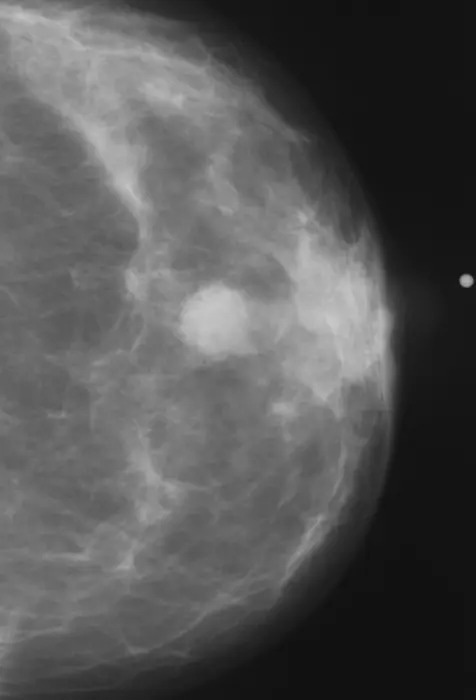Based on research presented at the annual conference of the Radiological Society of North America (RSNA), a deep learning artificial intelligence (AI) model was developed by utilizing only mammogram image biomarkers, which precisely predicted both ductal carcinoma in situ (DCIS) and invasive carcinoma.
 Abnormal Mammogram. Image Credit: Radiological Society of North America
Abnormal Mammogram. Image Credit: Radiological Society of North America
Moreover, this model has no bias across multiple races.
The patient’s risk of developing breast cancer in the future is diagnosed by the traditional breast cancer risk assessment models obtaining the data from patient questionnaires like medical and reproductive history.
In the domain of precision medicine, risk-based screening has been elusive because we have not been able to accurately evaluate a woman’s risk of developing breast cancer. Even the best existing traditional risk models do not perform well on the individual level.
Leslie R. Lamb M.D., M.Sc., Study Lead Author and Breast Radiologist, Massachusetts General Hospital
Conventional risk models have exhibited inadequate performance when applied to patients of various races, often stemming from the data employed to construct these models.
Traditional models likely have racial biases due to the populations on which they were developed. Several of the commonly used models were developed on predominantly European Caucasian populations.
Leslie R. Lamb M.D., M.Sc., Study Lead Author and Breast Radiologist, Massachusetts General Hospital
As per the American Cancer Society, Black women consistently exhibit the lowest 5-year relative survival rate for breast cancer compared to other racial and ethnic groups. This translates into a persistent 6% to 8% discrepancy in 5-year survival rates between Black and white women across all types of breast cancer.
Developing risk models that are universally applicable across diverse populations is crucial for accurately assessing breast cancer risk, enabling early detection, and enhancing patient survival rates.
A potential solution lies in developing deep learning AI risk assessment models solely using mammographic images. These models have the capacity to outperform traditional risk assessment methods in predicting future breast cancer occurrences while also minimizing the racial biases often observed in conventional models.
Dr. Lamb and his team conducted a pioneering study to evaluate the effectiveness of an image-based deep-learning risk assessment model in predicting future invasive breast cancer and DCIS (ductal carcinoma in situ) across various racial groups.
They evaluated the model's performance using the area under the receiver operating characteristic curve (AUC) and compared it through the DeLong test. The AUC score quantifies the model's predictive accuracy on a scale from 0 to 1.
Previous studies have indicated that traditional risk models typically achieve AUC values ranging from 0.59 to 0.62 for White women, with notably lower performance levels observed in women from other racial backgrounds.
The multisite study encompassed 129,340 routine bilateral screening mammograms conducted among 71,479 women between 2009 and 2018, with subsequent five-year follow-up data. Patient demographic details were extracted from electronic medical records, while instances of cancer were identified from the regional tumor registry.
The racial composition of the study group consisted of individuals categorized as White (106,839 exams), Black (6,154 exams), Asian (6,435 exams), self-reported other races (6,257 exams), and a category marked as unknown (3,655 exams). On average, the women in the study were 59 years old.
Remarkably, the deep learning model consistently outperformed traditional risk models in accurately predicting a woman’s likelihood of developing both DCIS (early-stage breast cancer) and invasive breast cancer (cancer with the potential to spread).
Leslie R. Lamb adds, “The model is able to translate the full diversity of subtle imaging biomarkers in the mammogram, beyond what the naked eye can see, that can predict a woman’s future risk of both DCIS and invasive breast cancer. The deep learning image-only risk model can provide increased access to more accurate, equitable, and less costly risk assessment.”
The predictive rate for both DCIS and invasive cancer stood at 0.71 across all racial groups. For DCIS prediction, the AUC was 0.77 in non-white patients and 0.71 in white patients. In the case of invasive cancer prediction, the AUC was 0.72 in non-white patients and 0.71 in white patients.
This is a particularly exciting domain for AI, as it demonstrates the opportunity to apply ‘AI for good’- to reduce well-known racial disparities in risk assessment. We are now poised to translate these findings into improved clinical care for our patients.
Constance D. Lehman M.D., Ph.D., Senior Author, Breast Radiologist, Massachusetts General Hospital
Additional co-authors are Sarah F. Mercaldo, Ph.D. and Andrew R. Carney, M.S.